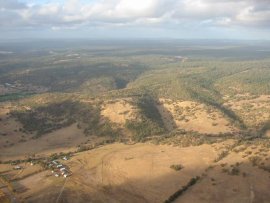Western Australia > Perth Region
Serpentine

| Type | Inland Ridge |
| Conditions | SW-WNW |
| Height | 400ft / 120m agl |
| Rating | PG Intermediate or Supervised with Advanced supervision / HG Intermediate |
If you haven't been here before, contact a local club, check on the current access arrangements, and organise your first flight with a club member who has good knowledge of this site. This site is privately owned, so is sensitive and could easily be lost. It is located on the Darling Scarp Drive about 5km south of Serpentine down Southwest highway. The site is just past the intersection with Kingsbury Drive. It's the hill with the phone tower on top. The landowner's house is at the bottom of the hill. IMPORTANT - It is necessary to get permission from the landowner before each day's flying.
Landowners
Private
Contact/Responsible
HGAWADescription
Good site on the Darling Scarp at Keysbrook.
Permission/Log in: The first pilots on site each day must check in with the owner before flying. If the owner cannot be contacted for any reason you may not enter the property. For this reason it is worthwhile to phone the owner before leaving home. One phone call per day or per group rather than one per pilot would be appreciated.
Flight
The site is situated on the main Darling Scarp. The take off is a large gently sloping grassy area below the summit. Wind streamer on the takeoff seem to indicate better wind direction than it really is, look at the windmills out front as well. In light conditions it is possible to launch near the top of the hill for extra height, although it can be rough until you get over the steep face. Because launch is a little below the top of the hill winds aloft may be a little stronger on takeoff.
The trees mean that flying low can be is nerve wracking on this site, and less experienced pilots have a tendency to fly too far out of the lift band and land. The site often exhibits strong thermal activity and rough air and sink. Be sure to allow enough height over the trees to cope with sink and collapses. Once a little height is gained the site is very enjoyable with great views. There appears to be good potential for cross country flights north or south along the scarp, but going over the back leads straight over extensive forest.
Supervised pilots should stay to the right of the gully to avoid being caught in the trees by sink.
Top landing is not recommended, although the cleared area is large, it is sloping and can have very rough air particularly if the wind is off to the south. Bottom landing is possible in any of the paddocks in front, but be aware of the powerlines. Low lying areas are very boggy in winter, spring and autumn.
Hazards / Comments
The site is flyable in a southerly wind, but the air can be quite turbulent if the wind is south of south west, particularly immediately on takeoff. DO NOT let go of the brakes (PG) or let your airspeed get low (HG) before getting over the steep slope and out of the turbulent area. Because of the shallow slope you may have to run again after launching if you start at the top.
If the wind is much north of west the take off area can be come very turbulent, and the gully to the right of launch even more so, suspect these conditions if you can't keep your glider inflated on launch.
The communication tower behind launch can be hazardous. Do not fly if there is a danger of being blown back because terrain behind is very unforgiving, the gully to the left of launch can create a venturi.
A high tension powerline runs down the gully to the right of launch and along the edge of the landing paddock, another runs parallel to the highway some distance inside the paddock, stay well away.
There are large areas of trees in front of the ridge in places, keep enough height to glide out even if heavy sink is encountered. This is an inland site, which means heavy sink is not unusual, it would be very easy to put yourself in a situation where you cannot avoid a tree landing.
The local wedgies are usually friendly but have been known to attack and tear gliders. Powerlines along one side, in between is a large area of tall trees. Away from the launch the trees extend further in front of the ridge, and right to the top.
Site records: PG: Open distance 24km Eric Metrot, December 02. Out and Return 12km Justin Post 2004. HG: ?